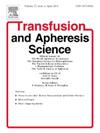鲁索利替尼在急性GVHD治疗中的作用。
IF 1.4
4区 医学
Q4 HEMATOLOGY
引用次数: 0
摘要
背景和目的:同种异体造血干细胞移植(alloo - hsct)后,发病率和死亡率的主要原因仍然是类固醇难治性急性移植物抗宿主病(SR-aGVHD)。最近,口服JAK1和JAK2抑制剂ruxolitinib被批准用于SR-aGVHD患者。本研究旨在分析鲁索利替尼在现实世界中的疗效和毒性。材料和方法:在本研究中,我们采用多中心回顾性分析的方法研究了ruxolitinib对SR-aGVHD患者的有效性和毒性。我们在2018年至2024年间招募了23名接受鲁索利替尼治疗SR-aGVHD的患者。结果:首次缓解中位时间为28天(范围12-150天)。鲁索利替尼治疗1个月后的总缓解率(ORR)为43.5 %(10/23),2个月后的总缓解率为61 %(14/23)。中位总生存期为69个月。巨细胞病毒再激活(26.1 %)和3-4级贫血(30.4 %)是鲁索利替尼治疗的两个主要副作用。7例患者(30.4 %)在中位随访6个月(范围1-70)后死亡。死亡原因包括败血症(n = 2,28.6 %)、aGVHD进展(n = 3,42.8 %)等原因。结论:Ruxolitinib治疗SR-aGVHD的ORR为61 %,使其成为现实环境中安全有效的治疗选择。本文章由计算机程序翻译,如有差异,请以英文原文为准。
The role of ruxolitinib in the management of acute GVHD
Background and objectives
Following an allogeneic hematopoietic stem cell transplant (allo-HSCT), a primary cause of morbidity and mortality is still steroid-refractory acute graft-versus-host disease (SR-aGVHD). Recently, ruxolitinib, an oral inhibitor of JAK1 and JAK2, was approved for use in individuals suffering from SR-aGVHD. This study aimed to analyze the efficacy and toxicity of ruxolitinib in the real world.
Material and methods
In the present study, we investigated the effectiveness and toxicity of ruxolitinib in patients with SR-aGVHD using a multicenter retrospective analysis. We enrolled 23 patients between 2018 and 2024 who received ruxolitinib treatment for SR-aGVHD.
Results
The first response was acheived in a median of 28 days (range, 12–150). The overall response rate (ORR) for ruxolitinib therapy was 43.5 % (10/23) after one month and 61 % (14/23) after two months, respectively. The median overall survival was 69 months. Reactivation of cytomegalovirus (26.1 %) and grade 3–4 anemia (30.4 %) were the two main side effects of ruxolitinib therapy. Seven patients (30.4 %) passed away following a follow-up of a median of six months (range 1–70). The reasons for death included sepsis (n = 2, 28.6 %), progression of aGVHD (n = 3, 42.8 %), and other reasons.
Conclusion
Ruxolitinib has an ORR of 61 % for SR-aGVHD, making it a safe and effective therapy choice in real-world settings.
求助全文
通过发布文献求助,成功后即可免费获取论文全文。
去求助
来源期刊
CiteScore
3.60
自引率
5.30%
发文量
181
审稿时长
42 days
期刊介绍:
Transfusion and Apheresis Science brings comprehensive and up-to-date information to physicians and health care professionals involved in the rapidly changing fields of transfusion medicine, hemostasis and apheresis. The journal presents original articles relating to scientific and clinical studies in the areas of immunohematology, transfusion practice, bleeding and thrombotic disorders and both therapeutic and donor apheresis including hematopoietic stem cells. Topics covered include the collection and processing of blood, compatibility testing and guidelines for the use of blood products, as well as screening for and transmission of blood-borne diseases. All areas of apheresis - therapeutic and collection - are also addressed. We would like to specifically encourage allied health professionals in this area to submit manuscripts that relate to improved patient and donor care, technical aspects and educational issues.
Transfusion and Apheresis Science features a "Theme" section which includes, in each issue, a group of papers designed to review a specific topic of current importance in transfusion and hemostasis for the discussion of topical issues specific to apheresis and focuses on the operators'' viewpoint. Another section is "What''s Happening" which provides informal reporting of activities in the field. In addition, brief case reports and Letters to the Editor, as well as reviews of meetings and events of general interest, and a listing of recent patents make the journal a complete source of information for practitioners of transfusion, hemostasis and apheresis science. Immediate dissemination of important information is ensured by the commitment of Transfusion and Apheresis Science to rapid publication of both symposia and submitted papers.

 求助内容:
求助内容: 应助结果提醒方式:
应助结果提醒方式:


